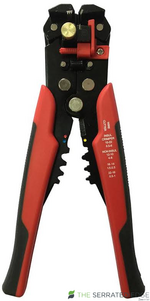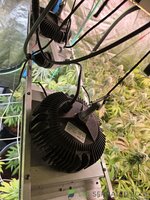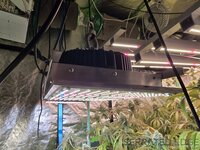It's more like knowing which Meanwell driver to get soas not to under/over-power the boards, then how to dial them up/down. Constant current, or constant voltage?? Do I wire-up the boards in series or parallel? Stuff like that. It's more a case of WHAT to do, rather than HOW to do it.
Again - not an expert - but from my observation and experience say this:
Meanwell drivers, you have two choices: HLG or XLG series. There are others, but these are the two I look at for higher power devices. I've only bought HLG series though. You want constant voltage and wattage. The main thing is to get the correct voltage (in this case 24v using the previously linked supplier) and selecting a wattage which gives you overheard from what the LEDs will draw.
For example, if you had 3 x 120 watt LED boards that = 360 wattts. In this case I would select the HLG-480H-24B which is a 480 watt, 24V supply with dimming. You might think oh cool, 480 watt supply, I might just wire in 4 x 120 watts since that's within spec. But that would be maxing out the driver
and cause it to run less efficiently which is not a good idea. EDIT:
ok maybe that isn't entirely correct - spec sheet shows efficiency goes up with power draw. I just learned that you should always have breathing room with a power supply from when I built 3D printers. We had to heat up chunks of aluminium to 110c and always had PSUs which had overhead for that. I apply the same logic for my DIY lights. I dunno if commercial lights do this though.
To identify which model you need, check the spec sheet:

I think with the AB model, because of the inbuilt potentiometer, you can use that to adjust brightness - but that would be annoying. So in either case, wire in a potentiometer to control brightness. Check both Mouser and Digikey for stock availability. They will be free ship from US and arrive within a week.
As for wiring in series or parallel - I don't think it matters. Parallel would mean redundancy if a board failed as you could swap it out. I've seen commercial lights done in both fashions. The LEDs will only draw the wattage they need, so if one failed in parallel it wouldn't be a hazard for the driver.
I buy all my wire via Aliexpress from this seller:
https://skymax.aliexpress.com/store/5062004
I then sourced some IP67 connectors like these:
https://www.aliexpress.com/item/1005003180200877.html
So that with a Mouser supplied driver, I wired up one of these (which came with a potentiometer but you can find them elsewhere) :
https://www.aliexpress.com/item/1005004798231336.html
Hope that helps

www.cutter.com.au













